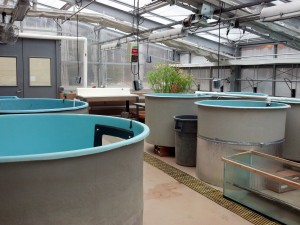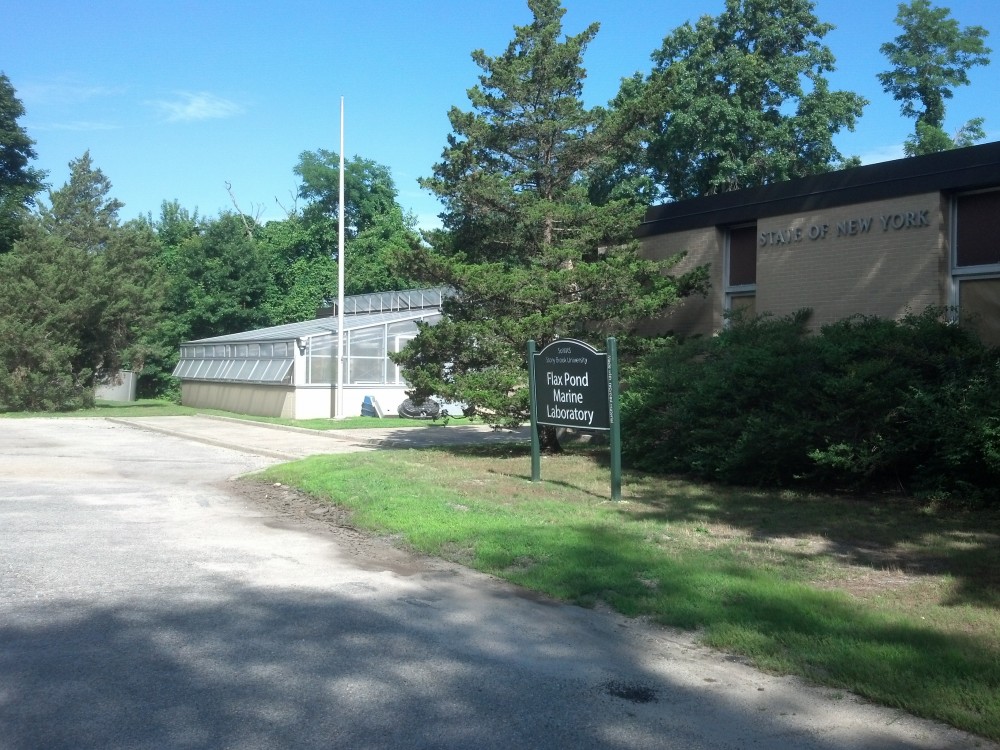The Flax Pond Marine Laboratory has a new greenhouse! After thirty years of service, the old greenhouse was retired, taken down and replaced.
 The previous greenhouse was put up in 1980. Built of aluminum and double-walled Lexan, it was initially used to grow species of local seaweed for subsequent microbial digestion into natural gas (methane). The oil crisis of 1979 had prompted an intensive, nationwide search for alternative fuels, including biomass-derived natural gas (the price of regular pipeline gas, a fossil-fuel, generally tracks that of oil). The Marine Biomass Project was funded by The Gas Research Institute and the New York State Energy Research and Development Authority and was managed by New York Sea Grant. The greenhouse was used to shelter the growing macroalgae from rain and snow, but allow for natural photoperiod cycles and temperature variation. However, the project was relatively short-lived. Oil supplies increased in the early 1980’s and, as the price of crude and pipeline gas plummeted by nearly 50% between 1980 and 1986, so did public and corporate interest in exotic fuel sources. The Marine Biomass Project ended by 1985. Over the ensuing years, a large number of fisheries projects and shellfish research projects ran in the greenhouse. For many of these, while the space’s natural photoperiod was a plus, its wide temperature extremes in summer and winter were a definite negative. Notwithstanding several refurbishments, the structure inevitable aged with time. The original Lexan panels lost their strength and transparency. In the early 1990’s, these panels were replaced with stronger twin-wall polycarbonate, providing greater light transmission over a wider portion of the electromagnetic spectrum. A few years later, better vents and vent fans were installed. These helped lower some of the mid-summer temperature spikes, but were not the whole solution. The constant exposure to salt spray and seawater corroded the aluminum framework of the greenhouse. The replacement panels began to leak and their supports began to fail. In 2008, during a project to replace the roof of the main laboratory building, a pallet of roofing materials was dropped through the greenhouse roof, destroyed a third of the structure. Repairs were made, but the structure was beyond tired and this was the coup de grace. A freak hail storm that same summer put hundreds of holes in the roof; the greenhouse was finished.
The previous greenhouse was put up in 1980. Built of aluminum and double-walled Lexan, it was initially used to grow species of local seaweed for subsequent microbial digestion into natural gas (methane). The oil crisis of 1979 had prompted an intensive, nationwide search for alternative fuels, including biomass-derived natural gas (the price of regular pipeline gas, a fossil-fuel, generally tracks that of oil). The Marine Biomass Project was funded by The Gas Research Institute and the New York State Energy Research and Development Authority and was managed by New York Sea Grant. The greenhouse was used to shelter the growing macroalgae from rain and snow, but allow for natural photoperiod cycles and temperature variation. However, the project was relatively short-lived. Oil supplies increased in the early 1980’s and, as the price of crude and pipeline gas plummeted by nearly 50% between 1980 and 1986, so did public and corporate interest in exotic fuel sources. The Marine Biomass Project ended by 1985. Over the ensuing years, a large number of fisheries projects and shellfish research projects ran in the greenhouse. For many of these, while the space’s natural photoperiod was a plus, its wide temperature extremes in summer and winter were a definite negative. Notwithstanding several refurbishments, the structure inevitable aged with time. The original Lexan panels lost their strength and transparency. In the early 1990’s, these panels were replaced with stronger twin-wall polycarbonate, providing greater light transmission over a wider portion of the electromagnetic spectrum. A few years later, better vents and vent fans were installed. These helped lower some of the mid-summer temperature spikes, but were not the whole solution. The constant exposure to salt spray and seawater corroded the aluminum framework of the greenhouse. The replacement panels began to leak and their supports began to fail. In 2008, during a project to replace the roof of the main laboratory building, a pallet of roofing materials was dropped through the greenhouse roof, destroyed a third of the structure. Repairs were made, but the structure was beyond tired and this was the coup de grace. A freak hail storm that same summer put hundreds of holes in the roof; the greenhouse was finished.
In spring 2009, SoMAS and Stony Brook University proposed to replace the dilapidated greenhouse. The SUNY Construction Fund in Albany authorized $350,000 for the project. An architectural firm was selected to design a new greenhouse. With substantial input and assistance from the University’s Facilities Design and Construction office, plans were drawn up and approved. The new greenhouse has a masonry kneewall around its perimeter, topped by opening windows. Automatic vents and circulation fans provide brisk interior air movement. Importantly, the new structure has a dedicated heat zone and tubefin heating and it will be fully usable year round. The greenhouse features a 4-zone adjustable shading system to allow for differential interior light levels to accommodate the needs of multiple users.
The construction started in late February/early March 2011, and the new greenhouse was completed in June.





You must be logged in to post a comment.